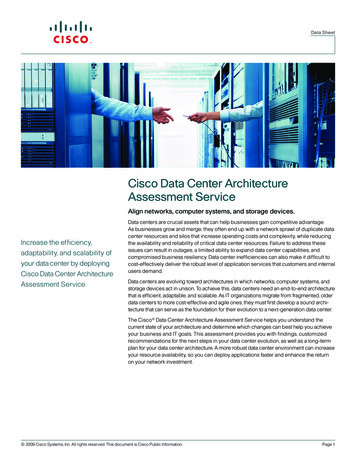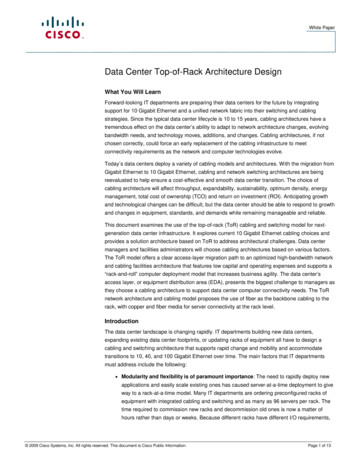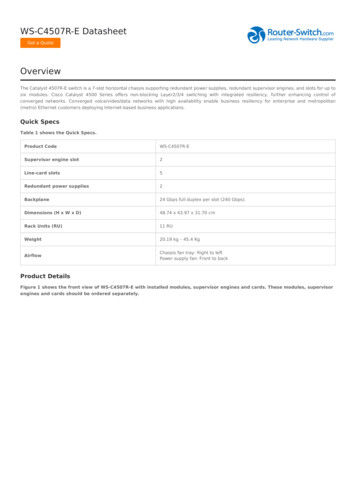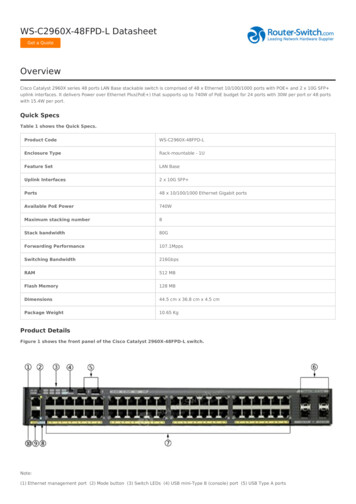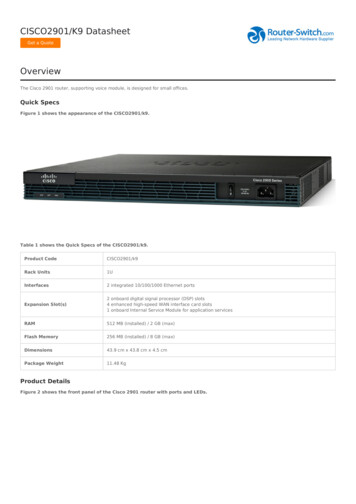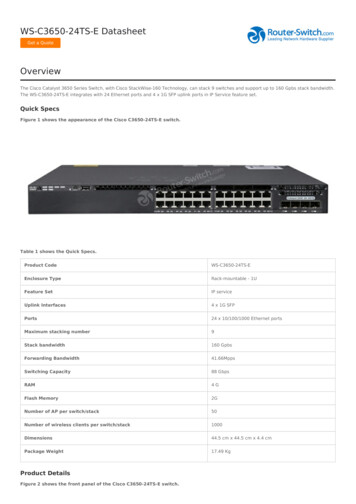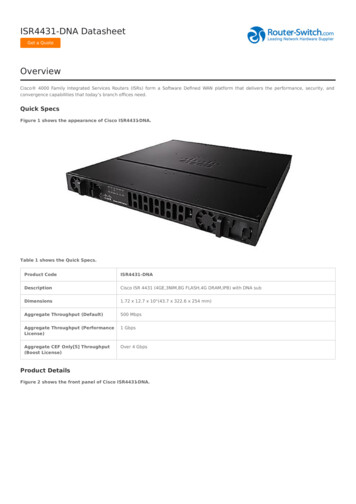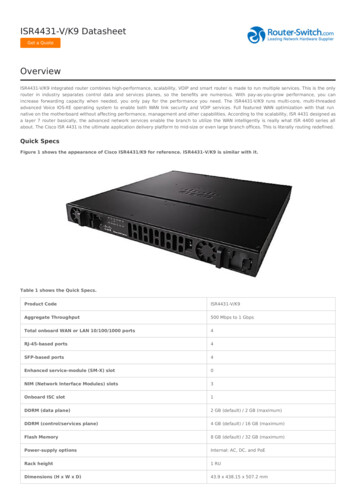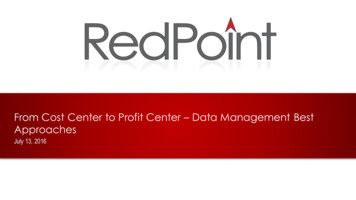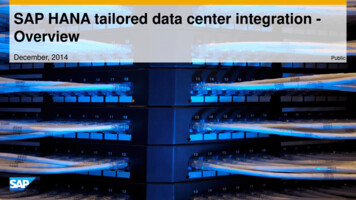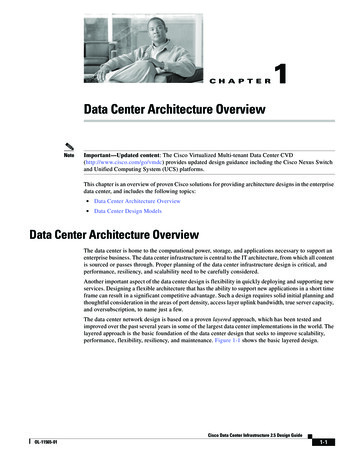
Transcription
C H A P T E R1Data Center Architecture OverviewNoteImportant—Updated content: The Cisco Virtualized Multi-tenant Data Center CVD(http://www.cisco.com/go/vmdc) provides updated design guidance including the Cisco Nexus Switchand Unified Computing System (UCS) platforms.This chapter is an overview of proven Cisco solutions for providing architecture designs in the enterprisedata center, and includes the following topics: Data Center Architecture Overview Data Center Design ModelsData Center Architecture OverviewThe data center is home to the computational power, storage, and applications necessary to support anenterprise business. The data center infrastructure is central to the IT architecture, from which all contentis sourced or passes through. Proper planning of the data center infrastructure design is critical, andperformance, resiliency, and scalability need to be carefully considered.Another important aspect of the data center design is flexibility in quickly deploying and supporting newservices. Designing a flexible architecture that has the ability to support new applications in a short timeframe can result in a significant competitive advantage. Such a design requires solid initial planning andthoughtful consideration in the areas of port density, access layer uplink bandwidth, true server capacity,and oversubscription, to name just a few.The data center network design is based on a proven layered approach, which has been tested andimproved over the past several years in some of the largest data center implementations in the world. Thelayered approach is the basic foundation of the data center design that seeks to improve scalability,performance, flexibility, resiliency, and maintenance. Figure 1-1 shows the basic layered design.Cisco Data Center Infrastructure 2.5 Design GuideOL-11565-011-1
Chapter 1Data Center Architecture OverviewData Center Architecture OverviewFigure 1-1Basic Layered DesignCampus CoreCoreAggregation10 Gigabit EthernetGigabit Ethernet orEtherchannelBackup143340AccessThe layers of the data center design are the core, aggregation, and access layers. These layers arereferred to extensively throughout this guide and are briefly described as follows: Core layer—Provides the high-speed packet switching backplane for all flows going in and out ofthe data center. The core layer provides connectivity to multiple aggregation modules and providesa resilient Layer 3 routed fabric with no single point of failure. The core layer runs an interiorrouting protocol, such as OSPF or EIGRP, and load balances traffic between the campus core andaggregation layers using Cisco Express Forwarding-based hashing algorithms. Aggregation layer modules—Provide important functions, such as service module integration,Layer 2 domain definitions, spanning tree processing, and default gateway redundancy.Server-to-server multi-tier traffic flows through the aggregation layer and can use services, such asfirewall and server load balancing, to optimize and secure applications. The smaller icons within theaggregation layer switch in Figure 1-1 represent the integrated service modules. These modulesprovide services, such as content switching, firewall, SSL offload, intrusion detection, networkanalysis, and more. Access layer—Where the servers physically attach to the network. The server components consistof 1RU servers, blade servers with integral switches, blade servers with pass-through cabling,clustered servers, and mainframes with OSA adapters. The access layer network infrastructure consistsof modular switches, fixed configuration 1 or 2RU switches, and integral blade server switches. Switchesprovide both Layer 2 and Layer 3 topologies, fulfilling the various server broadcast domain oradministrative requirements.Cisco Data Center Infrastructure 2.5 Design Guide1-2OL-11565-01
Chapter 1Data Center Architecture OverviewData Center Design ModelsThis chapter defines the framework on which the recommended data center architecture is based andintroduces the primary data center design models: the multi-tier and server cluster models.Data Center Design ModelsThe multi-tier model is the most common design in the enterprise. It is based on the web, application,and database layered design supporting commerce and enterprise business ERP and CRM solutions. Thistype of design supports many web service architectures, such as those based on Microsoft .NET or Java2 Enterprise Edition. These web service application environments are used by ERP and CRM solutionsfrom Siebel and Oracle, to name a few. The multi-tier model relies on security and applicationoptimization services to be provided in the network.The server cluster model has grown out of the university and scientific community to emerge acrossenterprise business verticals including financial, manufacturing, and entertainment. The server clustermodel is most commonly associated with high-performance computing (HPC), parallel computing, andhigh-throughput computing (HTC) environments, but can also be associated with grid/utility computing.These designs are typically based on customized, and sometimes proprietary, application architecturesthat are built to serve particular business objectives.Chapter 2, “Data Center Multi-Tier Model Design,” provides an overview of the multi-tier model, andChapter 3, “Server Cluster Designs with Ethernet,” provides an overview of the server cluster model.Later chapters of this guide address the design aspects of these models in greater detail.Multi-Tier ModelThe multi-tier data center model is dominated by HTTP-based applications in a multi-tier approach. Themulti-tier approach includes web, application, and database tiers of servers. Today, most web-basedapplications are built as multi-tier applications. The multi-tier model uses software that runs as separateprocesses on the same machine using interprocess communication (IPC), or on different machines withcommunications over the network. Typically, the following three tiers are used: Web-server Application DatabaseMulti-tier server farms built with processes running on separate machines can provide improvedresiliency and security. Resiliency is improved because a server can be taken out of service while thesame function is still provided by another server belonging to the same application tier. Security isimproved because an attacker can compromise a web server without gaining access to the application ordatabase servers. Web and application servers can coexist on a common physical server; the databasetypically remains separate.Cisco Data Center Infrastructure 2.5 Design GuideOL-11565-011-3
Chapter 1Data Center Architecture OverviewData Center Design ModelsResiliency is achieved by load balancing the network traffic between the tiers, and security is achievedby placing firewalls between the tiers. You can achieve segregation between the tiers by deploying aseparate infrastructure composed of aggregation and access switches, or by using VLANs (seeFigure 1-2).Physical Segregation in a Server Farm with Appliances (A) and Service Modules (B)(A)Web serversApplicationserversDatabaseservers(B)Web serversApplicationservers143341Figure 1-2DatabaseserversThe design shown in Figure 1-3 uses VLANs to segregate the server farms. The left side of theillustration (A) shows the physical topology, and the right side (B) shows the VLAN allocation acrossthe service modules, firewall, load balancer, and switch. The firewall and load balancer, which areVLAN-aware, enforce the VLAN segregation between the server farms. Note that not all of the VLANsrequire load balancing. For example, the database in the example sends traffic directly to the firewall.Cisco Data Center Infrastructure 2.5 Design Guide1-4OL-11565-01
Chapter 1Data Center Architecture OverviewData Center Design ModelsLogical Segregation in a Server Farm with VLANsABWeb nserversWeb servers143342Figure 1-3Physical segregation improves performance because each tier of servers is connected to dedicatedhardware. The advantage of using logical segregation with VLANs is the reduced complexity of theserver farm. The choice of physical segregation or logical segregation depends on your specific networkperformance requirements and traffic patterns.Business security and performance requirements can influence the security design and mechanismsused. For example, the use of wire-speed ACLs might be preferred over the use of physical firewalls.Non-intrusive security devices that provide detection and correlation, such as the Cisco Monitoring,Analysis, and Response System (MARS) combined with Route Triggered Black Holes (RTBH) andCisco Intrusion Protection System (IPS) might meet security requirements. Cisco Guard can also bedeployed as a primary defense against distributed denial of service (DDoS) attacks. For more details onsecurity design in the data center, refer to Server Farm Security in the Business Ready Data CenterArchitecture v2.1 at the following rprise/Data Center/ServerFarmSec 2.1/ServSecDC.html.Server Cluster ModelIn the modern data center environment, clusters of servers are used for many purposes, including highavailability, load balancing, and increased computational power. This guide focuses on the highperformance form of clusters, which includes many forms. All clusters have the common goal of combiningmultiple CPUs to appear as a unified high performance system using special software and high-speednetwork interconnects. Server clusters have historically been associated with university research,scientific laboratories, and military research for unique applications, such as the following: Meteorology (weather simulation) Seismology (seismic analysis) Military research (weapons, warfare)Cisco Data Center Infrastructure 2.5 Design GuideOL-11565-011-5
Chapter 1Data Center Architecture OverviewData Center Design ModelsServer clusters are now in the enterprise because the benefits of clustering technology are now beingapplied to a broader range of applications. The following applications in the enterprise are driving thisrequirement: Financial trending analysis—Real-time bond price analysis and historical trending Film animation—Rendering of artist multi-gigabyte files Manufacturing—Automotive design modeling and aerodynamics Search engines—Quick parallel lookup plus content insertionIn the enterprise, developers are increasingly requesting higher bandwidth and lower latency for agrowing number of applications. The time-to-market implications related to these applications can resultin a tremendous competitive advantage. For example, the cluster performance can directly affect gettinga film to market for the holiday season or providing financial management customers with historicaltrending information during a market shift.HPC Cluster Types and InterconnectsIn the high performance computing landscape, various HPC cluster types exist and various interconnecttechnologies are used. The top 500 supercomputer list at www.top500.org provides a fairlycomprehensive view of this landscape. The majority of interconnect technologies used today are basedon Fast Ethernet and Gigabit Ethernet, but a growing number of specialty interconnects exist, forexample including Infiniband and Myrinet. Specialty interconnects such as Infiniband have very lowlatency and high bandwidth switching characteristics when compared to traditional Ethernet, andleverage built-in support for Remote Direct Memory Access (RDMA). 10GE NICs have also recentlyemerged that introduce TCP/IP offload engines that provide similar performance to Infiniband.The Cisco SFS line of Infiniband switches and Host Channel Adapters (HCAs) provide highperformance computing solutions that meet the highest demands. For more information on Infinibandand High Performance Computing, refer to the following ex.html.The remainder of this chapter and the information in Chapter 3, “Server Cluster Designs with Ethernet”focus on large cluster designs that use Ethernet as the interconnect technology.Although high performance clusters (HPCs) come in various types and sizes, the following categorizesthree main types that exist in the enterprise environment: HPC type 1—Parallel message passing (also known as tightly coupled)– Applications run on all compute nodes simultaneously in parallel.– A master node determines input processing for each compute node.– Can be a large or small cluster, broken down into hives (for example, 1000 servers over 20 hives)with IPC communication between compute nodes/hives. HPC type 2—Distributed I/O processing (for example, search engines)– The client request is balanced across master nodes, then sprayed to compute nodes for parallelprocessing (typically unicast at present, with a move towards multicast).– This type obtains the quickest response, applies content insertion (advertising), and sends to theclient.Cisco Data Center Infrastructure 2.5 Design Guide1-6OL-11565-01
Chapter 1Data Center Architecture OverviewData Center Design ModelsHPC Type 3—Parallel file processing (also known as loosely coupled) – The source data file is divided up and distributed across the compute pool for manipulation inparallel. Processed components are rejoined after completion and written to storage.– Middleware controls the job management process (for example, platform linear file system[LFS]).The traditional high performance computing cluster that emerged out of the university and militaryenvironments was based on the type 1 cluster. The new enterprise HPC applications are more alignedwith HPC types 2 and 3, supporting the entertainment, financial, and a growing number of other verticalindustries.Figure 1-4 shows the current server cluster landscape.Server Cluster LandscapeHPC1 –Parallel Message PassingHPC2 –Distributed I/OHPC3 –Parallel File ProcessingDB –Data Ba
Data Center Architecture Overview † Data Center Design Models Data Center Architecture Overview The data center is home to the computational power, storage, and applications necessary to support an enterprise business. The data center infrastructure is central to the IT architecture, from which all content is sourced or passes through. Proper planning of the data center infrastructure design is
